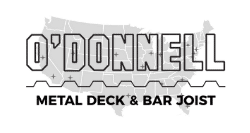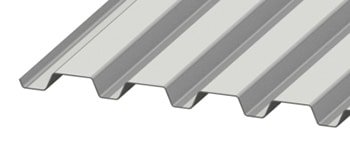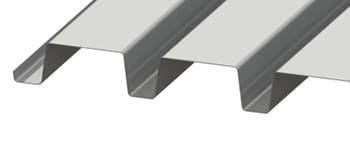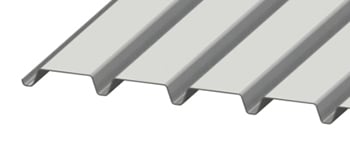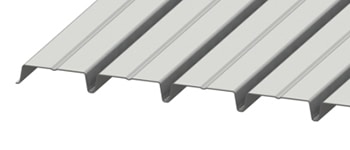
What is Roof Decking? How Does it Work?
Metal roof decking is a key structural building component in commercial steel construction of flat roofs. Corrugated roof deck is used for constructing and supporting the roof insulation and membrane. Metal roof decking is laid and fastened to a support structure, and then can be filled with insulation and covered with water proofing layers. Roof metal deck can span greater distances than other roofing materials and it carry greater loads across wider spans than other building materials.
The purpose of metal roof deck products are to serve as the structural base for roofing membranes in commercial roof construction. Typically, steel roof deck is installed directly over structural steel supports to provide a working platform and to allow for the installation of insulation, weatherproofing, and other roofing materials.
Additionally metal roof deck encloses a building from wind, it provides the necessary fire resistance for a UL roof assembly while snow loads, live loads, dead loads and or seismic & wind loads.
Metal Roof Deck FAQs:
What is Roof Deck Used For?
"O’Donnell Metal Deck roof deck products serve as the structural base for roofing membranes in commercial roof construction. Tyically Steel Roof deck is installed directly over structural steel supports to provide a working platform and to allow for the installation of insulation, weatherproofing, and other roofing materials.
How Far Can Roof Deck Span?
Every project has unique design criteria as determine by the EOR (engineer of record) and the EOR is responsible for specifying the metal deck that will meet this design criteria. The distance a profile can span is controlled by the gauge or thickness or the steel, the profile or shape of the product, the KSI of the steel coil.
What Are The Dimensions Of Roof Deck?
Metal Deck is made by rolling steel coil into various shapes called profiles. Thus, there are different types of roof decking that have unique dimensions and thus properties. The different metal roof deck profiles allow specifying engineers to design for specific requirements.
How Wide is Metal Roof Deck?
Most commonly 1.5 roof decking is 36" wide while 3.0 N deck is 24" or 32" wide. The width of metal roof decking profiles generally accounts for the overlap that is required and is often referred to as cover width.
Types of Metal Roof Decking
Common Roof Deck Profiles
The most common metal deck, is the 1.5 type B roof deck. B Decking has the best best balance of strength and economy of cost of all the roof deck products. When using B decking a minimum 1-inch thickness is required of rigid roofing insulation. Type B is also known as a wide-rib profile and is a high-performance and cost-efficient solution for multiple project requirements. Standard or cellular, acoustic or vented, interlocking or nested side laps, B deck is among the most flexible of our 1½-inch deep roof decks. 3" deep Type N Deck is a deep rib profiles that allows for larger spans and offers more open spaces. N Deck is most common in structures like gyms or auditoriums where there is a desire to limit the number of structural supports.
- B deck is the most common metal roof decking profile.
- B deck is the best choice for supporting a built-up roof span of less than 10 feet.
- B deck is modern 1.5" profile for installing rigid foam insulation over roof decking
- N deck is 3” deep which provides terrific support for longer spans of 8'-0" or greater.
- N deck is perfect for structures, like auditoriums and gymnasiums, where long structural components span large open spaces.
Uncommon Roof Deck Profiles
1.5 F and 1.5 A deck profiles are considered legacy profiles as the 1.5 B and 3.0 N types make up a majority of the market. Due to limited tooling runs the 1.5 Type F and 1.5 A decks are widely considered discontinued for new construction applications in many parts of the country. 1.5 F deck also known as intermediate rib can still be provided when insulation requirements for a project are lower. However, when applying F deck to a specification a minimum 1-inch thickness is required of rigid insulation. Most commonly these profiles are used by commercial roofers who are not completed a complete reroof.
- F deck is an old profile most commonly used in re-roofing applications where patching occurs
- F deck's intermediate rib profile is a weaker profile for span conditions compared to B Deck.
- F deck should be considered discontinued for new construction and is considered a legacy profile
- A deck is an old profile most commonly used in re-roofing applications where patching occurs
- A deck's narrow profile is the weakest profile for span conditions
- A deck should be considered discontinued for new construction and is considered a legacy profile
What Gauge is Roof Deck?
The metal deck gauge is a unit of measurement that refers to the thickness of the steel. The higher the gauge number the thinner the steel. The lower the gauge number the thicker or heavier the steel is.
Example 1: 18ga B deck is thicker, and therefore stronger and thus heavier than 22ga B Deck.
Example 2: 22ga B decking is thinner, and therefore lighter and thus weaker than 20ga B Deck
What Gauge Roof Deck Do I Need?
The (EOR) or Engineer of Record should be dictating the steel roofing decking gauge for the specific project . However, typically the rood deck gauge will depend on the below factors calculated by the engineer of record:
- Load capacities and/Concrete slab capacities
- Span capabilities of the deck during or after construction
- Diaphragm shear values
Below is a table of design thicknesses that are most commonly specified by EORs for metal roof decking.
Most Common Metal Roof Deck Gauges |
||||||
| Type | Gauge | Thickness / (in.") | (lbs. / ft2) | FM Span | SDI Max 1 Span | SDI Max 2 Span |
| 1.5 B | 16 (ga) | .0598 | 3.35 | 9'-6" | 8'-10" | 10'-5" |
| 18 (ga) | .0474 | 2.65 | 7'-5" | 7'-9" | 9'-1" | |
| 20 (ga) | .0358 | 1.95 | 6'-6" | 6'-5" | 7'-6" | |
| 22 (ga) | .0295 | 1.65 | 6'-0" | 5'-9" | 6'-9" | |
| Type | Gauge | Thickness / (in.") | (lbs. / ft2) | FM Span | SDI Max 1 Span | SDI Max 2 Span |
| 3.0 N | 16 (ga) | .0598 | 4.15 | 16'-6" | 17'-11" | 20'-8" |
| 18 (ga) | .0474 | 3.25 | 14'-7" | 15'-3" | 18'-0" | |
| 20 (ga) | .0358 | 2.45 | 12'-3" | 12'-9" | 15'-0" | |
| 22 (ga) | .0295 | 2.05 | 10'-10" | 11'-2" | 13'-2" |
1. SDI Maximum recommended single span for roofs.
2. SDI Maximum recommended multi span for roofs.
3. FM Maximum spans for Factory Mutual Class 1 construction.
a. Refer to the FM Approval Guide and FM 1-29 for fastening requirements and span restrictions at perimeter.
Why Does the Gauge of Roof Deck Matter?
As shown above, the gauge or how thick the steel is for any manufactured profile is the main driver for structural integrity but also the cost of metal decking. In laymen's terms, more steel costs more and therefore heavier the deck gauges are very likely to be more expensive. Inversely the opposite it true, a thinner deck gauge will likely reduce the cost of steel decking. Therefore it is important that the (EOR) is optimizing the steel deck design and specifying the correct gauge without over designing the steel deck.
Finally, if you are unsure of what gauge of metal deck is required or have questions it’s always appropriate to request the EOR to dictate this. While O’Donnell Metal Deck is capable of assisting design --- O'Donnell Metal is is not a structural engineering firm and we do not own liability for customer requests.
Roof Deck Finishes
The finish of the material used for steel deck is most commonly one of the three options below. It's important to note that typically in new construction the finish is dictated by the engineer and/or spefications. Therefore this typically isn't an option, but a requirement for a subcontractor looking to order metal roof deck. Thus, be sure to check your roof deck specifications and bid documents before placing an order.
- Uncoated steel, that is painted with primer on both sides.
- Sometime referred to as Cold Rolled Painted
- Galvanized steel
- Typically G-30,G-60 or G-90
- Galvanized steel that is painted with primer on one or both sides.
- Galv (G-30,G-60, G-90) & Either GRY or WHT Primer
Metal deck primer is applied to provide provisional protection for short periods of exposure. Therefore, uncoated steel with paint should only be considered a temporary coating not a finished product. A final coating is recommended as handling, transportation and jobsite conditions are expected to impact the quality of the finish.
Galvanized deck exposed to ordinary atmospheric conditions does not need to be field painted for structural purposes. Often times, painting galvanized deck is desired for aesthetic purposes. It’s important to note that proper steps are taken to ensure proper adhesion to galv coils if a primer is not applied at the factory. Various oils or chemicals used to prolong the life of the coil may impact paints ability to adhere properly.
Finishes are typically prime painted or galvanized and roof decks range in gage mostly from 22 to 16 at the heaviest.
| Roof Deck | Function | Finish | ASTM | Comment |
| Deck is not exposed to view, dry interior, non-corrosive environment | Cold Rolled, Primer Paint | A1008 | All Steel Deck shall be covered with a material sufficient insulating value to prevent condensation under normal occupancy conditions. Insulation shall be attached to the deck by adhesives or fasteners. Insulation material shall be protected from the elements at all times during the storage. See ASTM C1126-89 | |
| Deck is exposed to view; non-corrosive environment | Primer painted deck or G30 may also be adequate | A1008 or A653 | ||
| In moderately corrosive or high moisture atmospheres | A galvanized finish such as G-60 or G-90 coating | A653 | ||
| Highly corrosive or chemical atmospheres or where reactive materials could be in contact with steel deck | Contact us to discuss alternate options | n/a |
